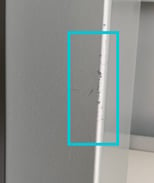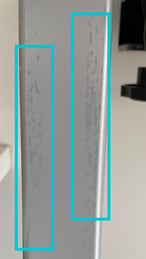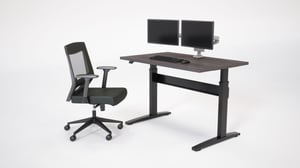While doing your research on your perfect standing desk, have you decided whether you want one that utilizes a steel column or an aluminum column? Did you even know that was something to consider before buying?
If your answer is "no," you're definitely not alone. It's an easy thing to miss, especially since most standing desk brands don't specify the differences between the two options. And not to mention, most of us don't even know what a desk column is or why we need to pay attention to which metal it's made of.
Well, I'm here to help provide you with some answers.
The first question we need to answer is, what is a desk column? The column is one of the components of the desk leg and base.

For standing desks in particular, the column includes either 2 or 3 telescoping tubes. The telescoping tubes slide in and out of each other so the desk column can extend from a sitting height to a standing height. The column houses the spindle gear that makes the desk move up and down. It will be attached to the desk foot and any other brackets or accessories, such as a cross support or worksurface support bracket.
Now you might be asking yourself, "why should I care about whether a standing desk has steel or aluminum columns?
The type of metal used to make a desk column has an impact on:
- Corrosion resistance
- Durability
- Design & Aesthetics
- Cost
Those four topics are important factors in figuring out which standing desk is worth your investment. This article will help breakdown the the differences between a steel vs. aluminum standing desk column so you can find out for yourself which one may be your best fit.
Steel vs. Aluminum Desk Columns article overview:
1. How each type are manufactured
2. Corrosion resistance
3. Durability
4. Design & Aesthetics
5. Cost
How It’s Made: Steel vs. Aluminum Desk Column
It's important that we first compare the manufacturing process of a steel standing desk column vs. one that's made of aluminum. This will help provide context for the topics we'll talk about later in the article.
Steel Desk Column Manufacturing Process
There are a couple of ways a steel desk column are made, but the most common is using a method called metal rollforming.
Simply put, metal rollforming is a process where steel passes through a series of rollers that bend the steel a little bit each time it passes from one roller stage to another. It will continue to go through various roller stages until the metal forms into a tube.

Here is the basic process of making a steel desk column:
1. A strip of steel passes through a series of rollers that gradually shape the steel into a cylindrical tube (the rollforming process).
2. Next, the two long edges of the steel tube are welded together. This creates a seam.
3. Once welding is complete, the tube passes through a water bath treatment to cool the metal.
4 .If the desk column needs to be square or rectangle, the steel tube will now move to a second series of rollers. After going through that second phase of rollforming, the cylindrical tube now has a more square or rectangular profile. However, if the desk column is designed to be cylindrical in shape, the shaping process is now complete and will not go through a second phase of rollforming.
5. The steel tubing is then cut to size.
6. Now, the tube will be punched, drilled, or machine cut to create holes for the column’s glide system.
7. If any brackets or attachments are needed for items like a cross support or drive system, they will be welded to the steel tube at this time. Additionally, if the desk base is designed to have the foot or work surface support bracket welded directly onto the column, this would also be completed at this time. If they are designed to be bolted to the column instead of welded, then just a metal plate is welded to the column for later assembly.
8. The tubing and welded brackets or attachments are sent to be painted. Typically only the outside of the tubing will be painted and the inside remains as raw steel.
9. Finally, the finished telescoping steel tubes are assembled to create the final desk column.
For more information on steel rollforming, you can check out this blog from McHone Industries: https://blog.mchoneind.com/blog/tubular-steel-made
Aluminum Desk Column Manufacturing Process
Aluminum desk columns are made from aluminum extrusions. Extrusion is a process that shapes a material, like aluminum, by forcing it through a die. Once pushed through, the material comes out as an elongated piece that has a profile identical to the die.
If you ever played with a Play-Doh Fun Factory as a kid, then you already have a bit of an understanding about the extrusion process. You can think of it this way:
- The Play-Doh is like the aluminum
- The lever is like the ram that forces the material through the die
- Each shape on the rail is like the extrusion die
Here’s the basic process of making an aluminum desk column:
1. Solid piece of aluminum is heated up to become more malleable, but it is still in a solid state.
2. Then, the heated aluminum is loaded into the extrusion press.
3. A ram applies continuous pressure to the malleable aluminum.
4. The aluminum is then forced through the opening of the extrusion die. An extrusion die is a steel disk that has one or more openings to create a specific profile. That profile will be the final profile of the material that’s pushed through it. The profile shape can be as simple or intricate as the manufacturer would like. The shape will sometimes include a T slot that makes it easy to attach a cross support or other accessories to the column during the assembly process.
5. Now, the aluminum extrusion comes out with the same profile as the die, and is guided onto the run out table.
6. The extruded aluminum is cooled down and cut to separate it from the extrusion process. It is then cooled a second time.
7. Next, it goes to the stretcher. A machine grabs the two ends of the extrusion and stretches it. This helps to straighten and correct the alignment of the extrusion.
8. Parts either painted or anodized.
9. This is followed by using a finishing saw to cut the extrusion to length.
10. The extrusions go through a finishing process where it may be painted or anodized.
11. Now, it’s the fabrication stage. This is where aluminum extrusion is punched, drilled, or machine cut to add any holes or openings that are required for final assembly. Welding is not required during this step to attach any brackets or attachments. That is because the T slot made from step #4 is used for attaching those items.
12. Lastly, the aluminum extrusion is assembled to create the final desk column.
Corrosion Resistance: Steel vs. Aluminum
Steel typically needs to be painted or treated to prevent corrosion and rust. When talking about a steel column for a standing desk, the outside is typically painted, but the inside is not. This means that the inside of a steel column runs the risk of becoming corroded.
Some manufacturers add a lubricant to the inside of the column to help decrease the risk, but it’s not a full-proof solution. The risk of corrosion is also increased if placed in an environment that’s wet, moist, or abrasive.
Aluminum on the other hand is highly resistant to corrosion without any use of a treatment or paint. An aluminum standing desk column is highly unlikely to have any corrosion.
Durability & Maleability: Steel vs. Aluminum
Steel is a strong metal, but it’s also rigid and less malleable. The properties of the steel limit the variety of available shapes for desk columns. The metal can crack or rip if it’s pushed too far during the shaping process.


A steel desk column will hold up well during the lifetime of the product, but the painted finish will be affected. Column glides will rub on the paint as the desk moves from a sitting to standing position which causes a wear line. It’s also normal for some dirt and dust to accumulate on the column glides. This creates additional friction between the glide and the painted column which will increase the wear on the paint. Also, there’s always the potential for paint to chip over time.
Aluminum columns are just as strong as those made of steel. This is made possible by increasing the wall thickness of the column.
Also, aluminum is much more malleable than steel. Being more moldable allows the aluminum to go through the extrusion process, so the metal can be shaped without the potential of cracking or breaking.
Anodized aluminum is especially durable. The anodization process doesn't add a coating to the metal like it does with paint. Instead, it's an electrochemical process that changes the chemical properties of the aluminum. This means that not only is the aluminum becomes significantly stronger, but the anodized finish will never chip, peel, or rust.
Overall, anodized aluminum standing desk columns are significantly more durable than painted steel columns. If you're looking for your standing desk to have a long lifespan, you should highly consider one that had anodized aluminum leg columns.
Design & Aesthetics: Steel vs. Aluminum
When it comes to aesthetics, steel columns tends to be more simplistic and less intricate in comparison to aluminum. This is largely due to the fact that steel is not as malleable or easily moldable. The shape choices for a steel desk column include: round, rectangular, or square. The outer walls of the columns are generally flat and won't have any intricate design detail.
Additionally, steel desk columns are only offered with a painted finish. Some brands may offer a variety of colors, but the common offerings are white, gray, and black.
A downside to a painted finish is that it shows wear and tear more easily. Over time, the inner most telescoping tube will begin to show wear from the column glides. It's also easier for chipping and scratches to occur.
Conversely, aluminum standing desk columns tend to have a more detailed design and high-end look. The extrusion process makes it possible The profile of an aluminum desk column can be just about any shape, so the design can be much more intricate and unique.
Aluminum desk columns can be painted, but it’s much more common that they’re anodized. This gives a much richer look. When anodized, the column will not show wear and tear like it would with a painted column. An anodized aluminum desk column won't show wear from glides, chip, or scratch.
Cost: Steel vs. Aluminum
While cost can fluctuate, steel tends to cost less than aluminum. So, you will notice that steel columns often cost less than aluminum. That is not factoring in any other components of a standing desk that may influence price (ie. technological components, where it’s manufactured, etc.).


COMMENTS